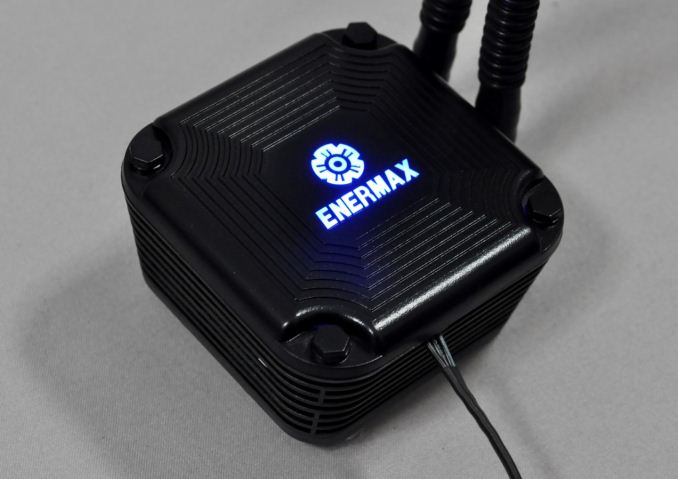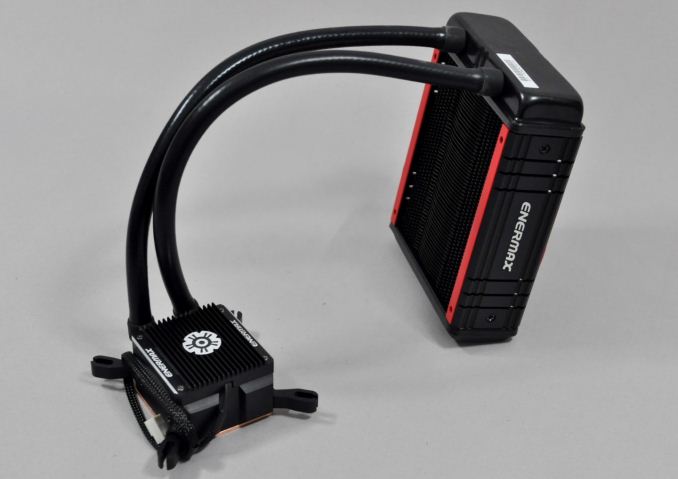Closed Loop AIO Liquid Coolers: 14-way Mega Roundup Review
by E. Fylladitakis on February 12, 2014 7:00 AM ESTEnermax
Enermax gained popularity and reputation through their high quality power supply units. The company has been around for decades but has only more recenty begun diversifying into cases and cooling solutions. They have also added a couple of new AIO liquid coolers into their product range and they shipped us two of them for this review. Unfortunately, these coolers are not yet available in the North American region.
Enermax Liqmax 120S
The first AIO liquid cooler from Enermax is the Liqmax 120S. The Liqmax series consists of two products, which are essentially the same cooler but with a different fan. Both models are depicted on the box. We received the LM120S-HP model, and the fan of lacks LED lighting on this model.
Even though the bundle of the Liqmax 120S is nothing special, it comes well presented, with the mounting hardware packed in separate nylon bags. There also is a manual with installation instructions and a syringe with thermal compound included. The biggest attraction of this kit however is definitely the fan. Although it looks like a simple, black fan without lighting or any notable features, there is a switch on the fan's engine that adjusts the speed range of the fan. There are three settings: 600 to 1300 RPM, 600 to 2000 RPM and 600 to 2500 RPM. By default, the fan is set on the 600 to 2000 RPM range.
Visually, the Liqmax 120S is not much different from most other AIO coolers with 120mm wide radiators. The radiator, measuring 32mm deep, is slightly thicker than the one used by the Seidon 120V and the Corsair H75. There are almost no deformations or imperfections about the aluminum fins, although a couple of them are slightly bent. Enermax went with black corrugated tubing, which is durable but a bit of a pain to turn. At least the connections on the block can turn sideways, relieving some of the stress.
The block-pump assembly is entirely made of plastic, with the exception of the copper base of course. Although plastic makes such designs look cheap, Enermax tried to improve the appearance of their product by engraving a symmetric pattern on it, grooves on its sides, and added blue LED lighting beneath their company logo in the middle of the block. It does help but the block of the 120S is definitely not the best looking around. The copper base of the block however is very well made, smooth and machined down to a nearly perfect finish.
Enermax Liqtech 120X
Despite the name, not Liqmax but Liqtech is actually the best series of Enermax's AIO cooling solutions. There are two versions with different radiators, the 120X and the 240. We received the small version, the 120X, supplied in a very well designed black/red cardboard box.
The bundle of the Liqtech 120X consists of the standard items; a manual with installation instructions, mounting hardware, and a syringe with thermal compound. Enermax also supplies a 3-pin Y-splitter fan cable, which can be used to power two fans off a single header. Two 120mm fans are supplied with the Liqtech 120X, both being the same as the black range-adjustable ELC-LT120HP fan of the Liqmax 120S kit.
If this were a beauty contest, the Liqtech 120X would be the most serious contestant. Enermax definitely spent a lot of time and energy designing the 120X so as to stand out from the crowd. The radiator has grooved aluminum blocks attached to its sides, with the company logo printed on them. Anti-vibration material forms red stripes where the fans will be seated. The design of the radiator itself is very different from that of most other kits as well; instead of wavy aluminum fins between the liquid pass-through channels, this design forms single, "seamless" fins from one side to the other. It is considerably thicker as well, measuring 43mm deep, which can be a problem in some system cases.
The block-pump assembly is entirely metallic as well, with an aluminum frame and a copper base. The black aluminum top of the block forms fins, which sort of function as a small heatsink, with the company name and logo clearly visible in silver. Even the mounting supports are made out of solid aluminum, with those for installation on an Intel CPU already attached to the block. The copper base is clean, smooth and very well machined. This AIO cooler obviously is a very different design than those from Asetek and or CoolIT; Enermax however did not want to reveal their source.
























139 Comments
View All Comments
piroroadkill - Wednesday, February 12, 2014 - link
This is great, but where's at least a couple of air coolers in there for reference?I'd recommend the ever popular and classic Noctua NH-D14 since it's a widely reviewed, well known reference point.
piroroadkill - Wednesday, February 12, 2014 - link
If only I could edit my reply. I see that there is a category in Bench for CPU coolers. Never mind!ddriver - Wednesday, February 12, 2014 - link
It would still be a good idea to include a few high performance air coolers to compare how they do against the low end h2o coolers.just4U - Thursday, February 13, 2014 - link
Or even a Coolermaster 212 which is pretty much the go-to HSF for standard builds due to cost/cooling performance.MrSpadge - Wednesday, February 12, 2014 - link
Agreed - one standard high performance air cooler for ~50€ would suffice, but not including any feels incomplete.jmke - Wednesday, February 12, 2014 - link
so true, would have been a very good idea to throw in a €20 and €50 air cooler, using one of the 120mm fans to see how these water coolers compare.jmke - Wednesday, February 12, 2014 - link
best performance/noise CPU coolers is the Noctua in their charts. One of the best AIO is the NZXT Kraken X60. Let's see how they stack up:Noctua NH-U14S (2 Fans 100%) 43.1°C / 33.3 dBA / €70
NZXT Kraken X60 (Silent) 41.2°C / 30.5 dBA / €140
is a few °C difference worth an extra €70? is a HSF worth €70?
how important is CPU temperature?
if you don't overclock, keeping CPU temp below max would suffice...
mr_tawan - Wednesday, February 12, 2014 - link
Personally I use closed-loop water cooler(corsair H60) because the large air cooler I used (CM Hyper212) gets in the way of ram modules (people with intel chip does not suffer from this, AFAIK). With water cooler, I can put 4 DIMM on the mainboard without any problems.In my system, there is no significant differences between these two cooler. Water cooler is a little bit louder, btw.
Idonno - Saturday, December 6, 2014 - link
I agree 100%. Plus the sheer weight (on the MB and CPU) and size that an air cooler like the Noctua NH-U14S has to be to be even remotely competitive is absolutely ridiculous.It's not just the better temps that closed loop water coolers provide, it's convenience, accessibility, less strain on critical components and better temps.
All-in-all the higher cost of closed loop water coolers is IMO worth every penny.
E.Fyll - Wednesday, February 12, 2014 - link
Unfortunately, the few air coolers that I still have in my house are outdated. Yet, there will be many air cooler reviews and roundups coming in the near future, with their results directly comparable to those of this review. :)